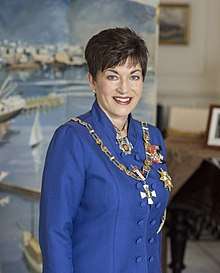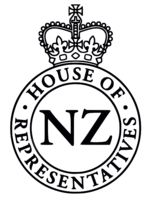Governor-General of New Zealand
| Governor-General of New Zealand
Kāwana Tianara o Aotearoa (Māori) | |
|---|---|
 Badge | |
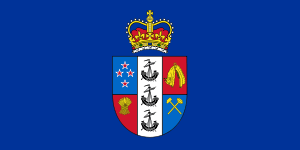 | |
| Viceroy | |
| Style | Her Excellency the Right Honourable |
| Residence | |
| Nominator | Prime Minister of New Zealand |
| Appointer | Monarch of New Zealand |
| Term length | At Her Majesty's pleasure (usually 5 years by convention) |
| Formation | 3 May 1841 |
| First holder |
William Hobson as Governor of New Zealand |
| Salary | NZ$354,000[1] |
| Website |
www |
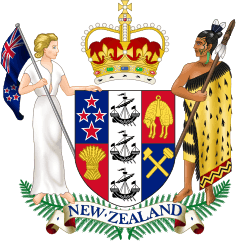 |
|---|
| This article is part of a series on the politics and government of New Zealand |
| Constitution |
|
|
|
|
Related topics |
|
|
The Governor-General of New Zealand (Māori: Te Kāwana Tianara o Aotearoa) is the viceregal representative of the monarch of New Zealand, currently Queen Elizabeth II. As the Queen is shared equally with the 15 other Commonwealth realms, and normally resides in the United Kingdom, she, on the advice of her prime minister, appoints a governor-general to carry out most of her constitutional and ceremonial duties within the Realm of New Zealand. Once in office, the governor-general maintains direct contact with the Queen, wherever she may be at the time.
The current office traces its origins to when administration of New Zealand was placed under the Colony of New South Wales in 1839 and its governor was given jurisdiction over New Zealand. However, New Zealand would become its own colony the next year with its own governor. The modern "governor-general" and his or her functions came into being in 1917 and the office is currently mandated by letters patent issued in 1983, constituting "the Governor-General and Commander-in-Chief of the Realm of New Zealand".[2] Constitutional functions of the governor-general include presiding over the Executive Council, appointing ministers and judges, dissolving parliament, granting Royal Assent to legislation, issuing writs for elections and bestowing honours. These functions are generally exercised only according to the advice of an elected government. The governor-general also has an important ceremonial role: hosting events at Government House in Wellington, and travelling throughout New Zealand to open conferences, attend services and commemorations and generally provide encouragement to individuals and groups who are contributing to their communities. When travelling abroad, the governor-general is seen as the representative of New Zealand; for this reason, the governor-general is viewed by some as the de facto head of state.[3][4][5]
The governor-general (titled "governor" before 1917) initially represented the British monarch and the British Government. Therefore, many past officeholders were British, including a succession of minor aristocrats from the 1890s onwards. In a gradual process, culminating with the adoption of the Statute of Westminster in 1947, the governor-general has become the independent, personal representative of the New Zealand monarch. In 1972, Sir Denis Blundell became the first New Zealand resident to be appointed to the office.
Governors-general are not appointed for a specific term, but are generally expected to serve for five years. The current Governor-General is Dame Patsy Reddy, who has served since 28 September 2016; Prime Minister John Key recommended her to succeed Sir Jerry Mateparae.[6] Administrative support for the governor-general is provided by the Department of the Prime Minister and Cabinet.
Appointment
The New Zealand monarch appoints the Governor-General by commission.[7] Constitutional convention adopted in 1930, following the Imperial Conference held that year, allowed for the appointment of the Governor-General to be made upon the advice of the New Zealand Government. However, the right granted by the convention was not exercised directly by a New Zealand Prime Minister until 1967.[8] The Prime Minister's advice has sometimes been the result of a decision by Cabinet,[9] although there is no requirement for this. There have been a few instances where the Governor-General was appointed with no consultation of Cabinet. Since 1980, the Department of the Prime Minister and Cabinet prepares a short list of candidate for the office.[10] By convention, the Leader of the Opposition is also consulted on the appointment,[11] however this too has not always been the case. More recently, the introduction of MMP has meant the Prime Minister primarily consults with each of the party leaders in the House of Representatives.[12] On only one occasion has the Prime Minister's choice of appointee aroused public anger or complaint, and that controversy was short-lived.[10]
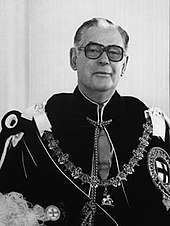
In 1977, Sir Keith Holyoake, a former National Party Prime Minister and a serving Minister of State, was controversially appointed as Governor-General.[14] The Leader of the Opposition, Bill Rowling, complained he had not been consulted by Prime Minister Robert Muldoon on the appointment of Holyoake,[15] and openly suggested that he would have appointed Sir Edmund Hillary as Governor-General instead.[16] (Rowling's remark was in turn criticised by the Government, as Sir Edmund had backed Labour in 1975 as part of the "Citizens for Rowling" campaign.[17]) It was suggested by many commentators that it would be inappropriate to entrust the office to a former party leader or anyone who is closely allied with a political party; however, despite his background, Holyoake could not be said to have discharged his duties in a partisan way, and he served for only three years.[14][11] Since the 1970s, the Prime Minister has always confided with the Leader of the Opposition during the nomination process, in an attempt to reduce partisan influence.[11]
Beginning with the appointment of Sir David Beattie in 1980, lawyers and judges have predominated as governors-general.[18] Following the introduction of MMP, it has been determined that an understanding of constitutional law is an important prerequisite for candidacy to the office.[10]
There has been on-and-off speculation that a member of the Royal Family might take up the position. In 2004, National MP Richard Worth, an avowed monarchist, asked the then Prime Minister Helen Clark whether she had considered nominating the Earl of Wessex to be the next Governor-General.[19]
Swearing-in ceremony
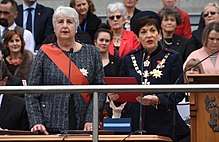
Before the Governor-General enters office, his or her commission of appointment is publicly read in the presence of the Chief Justice of New Zealand (or any other High Court Judge) and the members of the Executive Council. The Governor-General must take the Oath (or Affirmation) of Allegiance, and the oath (or affirmation) for the due execution of the office, which the Chief Justice or other High Court Judge administers.[20]
Election proposals
From time to time, there have been proposals to elect the Governor-General. When first drafted by then Governor George Grey, the New Zealand Constitution Act 1852 contained provision for the Governor to be elected by New Zealand's Parliament. This provision was removed from the final enactment, probably because the Colonial Office wanted to keep a check on New Zealand's colonial government. In 1887, Sir George Grey, by then also a former Premier, moved the Election of Governor Bill to make the office of Governor an elective position. The Bill was narrowly defeated 46–48, being opposed by the government of Harry Atkinson.[21] In 1889, Grey tried again with another Bill, which if passed would have allowed for a "British subject" to be elected to the office of Governor "precisely as an ordinary parliamentary election in each district."[22]
In 2006, political commentator Colin James suggested that the Governor-General could be elected[23] (or, more correctly, 'nominated' to the Queen) by a 60% majority of votes cast in Parliament. James argued that the New Zealand public should be given the ability to choose the Queen's representative, and that the current system is undemocratic and not transparent. Such a system is not unique: the Governors-General of Papua New Guinea and the Solomon Islands are nominated in such a way. Constitutional law specialist Professor Noel Cox, who is a former chair of Monarchy New Zealand, criticised the proposal, claiming that "[g]iving the Governor-General a new and separate source of democratic legitimacy could result in a separation between Ministers and Governors-General. ...the Governors-General would have their own independent popular mandate, and become potential political rivals of the Ministers".[24]
In February 2008, the Republican Movement suggested electing the Governor-General as an interim step to a republic, arguing "Electing the Governor-General allows for easier transition to a republic, because the populace is used to electing someone as a ceremonial de facto head of state."[25] With the introduction of the Governor-General Act 2010, Green MP Keith Locke suggested Parliament recommend the next Governor-General's appointment to the Queen, with a recommendation endorsed by three-quarters of parliament.[26] In its submission to the select committee considering the Bill, the Republican Movement suggested parliament appoint the next Governor-General with a three-quarters majority plus a majority of party leaders in parliament, with a similar dismissal process and a fixed five-year term.[27] National MP Nikki Kaye queried whether several one-member parties in parliament could veto the decision, which could give them too much power if an appointment was based on one vote per leader. The Republican Movement responded that the method would ensure appointments were made that most MPs and parties found acceptable.[27]
Tenure
| Wikisource has original text related to this article: |
The Governor-General holds office "at the monarch's pleasure", under clause II of the 1983 letters patent. It is the norm that an appointed individual holds office for a minimum of five years but this tenure may also be extended. For instance, Dame Silvia Cartwright would have been in office for five years on 4 April 2006, but her term as Governor-General was extended by four months as Prime Minister Helen Clark deemed that "the selection and appointment process [of a new governor-general] [should] not coincide with the pre-election period".[28]
Administrator of the Government
A vacancy will occur on the resignation, death, incapacity or absence from New Zealand territory of the Governor-General. In the absence of the Governor-General the Chief Justice acts as the Administrator of the Government, or simply Administrator in everyday usage.[29]
Prior to the granting of responsible government in 1856, the Colonial Secretary (the colonial equivalent of the Minister of Internal Affairs) acted as Administrator of the Government in absence of the Governor.[30]
Dismissal
The Prime Minister may advise the Queen to recall the Governor-General, and (so long as the Prime Minister has the confidence of the House of Representatives) the Queen is bound by convention to implement the advice of her Prime Minister. As no New Zealand Governor-General has ever been dismissed on the advice of the Prime Minister, it is unclear how quickly the Queen would act on such advice. Some constitutional lawyers dispute whether the Queen would implement such advice at all, while others argue that the Queen would delay its implementation. Others argue that the Queen would be obliged to follow the Prime Minister's advice, and further that the Queen would be bound to implement the Prime Minister's advice immediately if so advised.[31]
Critics (such as supporters of a New Zealand republic) have described the ability of the Prime Minister to advise the Queen to recall the Governor-General as a flaw in New Zealand's constitutional make up that gives the Governor-General and the Prime Minister the ability to dismiss one another.[32] They argue that this flaw is exacerbated by the reluctance of the monarch or their representatives to become politically involved.[32]
Three New Zealand governors have been recalled from office: William Hobson (who died before he was officially recalled),[33] Robert FitzRoy[34] and Sir George Grey,[35] all before responsible government was granted in 1853.
Functions
The Governor-General's functions can be informally divided into three areas: constitutional, ceremonial and community.[36]
Constitutional role
The Governor-General is a nominal chief executive, acting within the constraints of constitutional convention and precedent. Almost always, the Governor-General exercises the Royal Prerogative on the formal advice of the Prime Minister and other ministers. The Prime Minister and ministers are, in turn, accountable to the democratically elected House of Representatives, and through it, to the people.[37] The Constitution Act 1986 provides that "the Governor-General appointed by the Sovereign is the Sovereign's representative in New Zealand".[38] The Governor-General exercises a number of the remaining Royal Prerogatives, and the reserve powers.
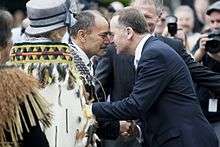
In practice, political power is exercised by the New Zealand Parliament (which is composed of the Governor-General-in-Parliament, and the House of Representatives), through the Prime Minister and Cabinet.[39] By constitutional convention, the Governor-General exercises his or her powers solely on the advice of the Prime Minister and ministers—the only exception being when the Prime Minister loses the confidence of the House of Representatives.[7] Even in the appointment of the Prime Minister, the Governor-General rarely exercises any discretion; in accordance with unwritten constitutional conventions, the Governor-General must appoint the individual most likely to maintain the support of the House of Representatives: this is usually the leader of the largest party.[40]
As a matter of law, the Governor-General is not in the same constitutional position as the Sovereign; the office itself does not independently possess any powers of the Royal Prerogative. If present in New Zealand, the monarch may exercise her powers personally.[38] Furthermore, some powers, such as the approval of a new Royal Honour, may be exercised by the monarch alone.[41]
The powers conferred on the Governor-General are formally stated in the Letters Patent 1983.[2] The Governor-General also has custody of the Seal of New Zealand for all official instruments of Her Majesty's Government in New Zealand.[42]
Executive Council
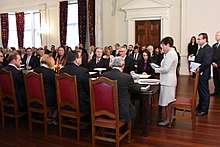
The Governor-General presides over, but is not a member of, the Executive Council.[43] The Prime Minister is appointed to this Council and advises as to which parliamentarians shall become ministers and parliamentary secretaries. The Executive Council's primary function is to issue Orders in Council (regulations), which operate under the authority of "the Governor-General in Council".
| “ | Every reference in any Act to the Governor-General in Council or any other like expression includes a reference to the Sovereign acting by and with the advice and consent of the Executive Council. | ” |
| — Section 3 of the Constitution Act, [38] | ||
Parliament and Cabinet
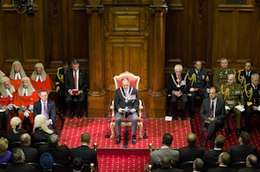
The Governor-General also summons and dissolves Parliament.[7] Each parliamentary session begins with the Governor-General's summons. The new parliamentary session is marked by the opening of Parliament, during which the Governor-General reads the speech from the throne in the Legislative Council Chamber, outlining the Government's legislative agenda. Dissolution ends a parliamentary term (which lasts a maximum of three years), and is followed by general elections for all seats in the House of Representatives. These powers, however, are always exercised on the Prime Minister's advice. The timing of a dissolution is affected by a variety of factors; the Prime Minister normally chooses the most politically opportune moment for his or her party.[44] The Governor-General may theoretically refuse a dissolution, but the circumstances under which such an action would be warranted are unclear.[45] It might be justified if a minority government had served only briefly and another party seemed likely to have better success in holding the confidence of the House.
| “ | People tend to think the office of the Governor-General is of little significance, which is wrong, or that it represents a substantial check on the excesses of executive government, which is also wrong. | ” |
| — Sir Geoffrey Palmer[46] | ||
Before a bill can become law, the Royal Assent is required. The Governor-General acts on the Monarch's behalf; in theory, he or she may grant the Royal Assent (making the bill law), or withhold the Royal Assent (vetoing the bill). By modern constitutional convention, however, the Royal Assent is invariably granted, and Bills are never disallowed.[47]
The Governor-General appoints and dismisses Cabinet ministers and other ministers, but exercises such a function only on the Prime Minister's advice. Thus, in practice, the Prime Minister, and not the Governor-General, exercises complete control over the composition of the Cabinet. The Governor-General may, in theory, unilaterally dismiss a Prime Minister, but convention and precedent bar such an action.[47]
Reserve powers
| “ | The Queen has the power to appoint and dismiss Ministers and other important office holders, summon and dissolve Parliament, assent to Bills passed by the House of Representatives, and agree to regulations and Orders submitted by Ministers through Executive Council. The Queen delegates most of her powers to her representative, the Governor-General. While the Queen and her representative exercise these powers as a matter of law, as a matter of convention, both the Queen and the Governor-General act on the advice of the democratically elected government, in all but the most exceptional circumstances. | ” |
| — Former Governor-General Dame Silvia Cartwright, [48] | ||
The Governor-General always acts with the advice of the Prime Minister, unless the Prime Minister has lost the confidence of the House of Representatives.[49] These are the so-called "reserve powers". These powers include the ability to:
- Dissolve or prorogue Parliament;
- Appoint or dismiss Cabinet ministers and the prime minister;
- Refuse a prime minister's request for a dissolution;
- Refuse assent to legislation.[50][45]
The exercise of the above powers is a matter of continuing debate. Many constitutional commentators believe that the Governor-General (or the Sovereign) does not have the power to refuse Royal Assent to legislation —former law professor and Prime Minister Sir Geoffrey Palmer and Professor Matthew Palmer argue that any refusal of Royal Assent would cause a constitutional crisis.[46] However, some constitutional lawyers, such as Professor Philip Joseph, believe the Governor-General does retain the power to refuse Royal Assent to Bills in exceptional circumstances, such as the abolition of democracy.[51]
As with other Commonwealth realms, the Governor-General's exercise of the royal prerogatives under the reserve powers is non-justiciable;[52] that is, they cannot be challenged by judicial review, unlike the actions of other members of the executive (such as the Prime Minister in Fitzgerald v Muldoon.[53])
Royal prerogative of mercy
The Governor-General also exercises the royal prerogative of mercy, an ancient right of convicted persons to seek a review of their case where they allege an injustice may have occurred. The prerogative of mercy can be exercised where a person claims to have been wrongly convicted or wrongly sentenced.[54]
The Governor-General acts on the advice of the Minister of Justice. The Governor-General has power to grant a pardon, to refer a person's case back to the court under section 406 of the Crimes Act 1961, and to reduce a person's sentence. If a person's case is referred back to the court, the court will consider the case in a similar way to hearing an appeal. The court then provides advice to the Governor-General as to how to act. Recently, David Bain was granted such an appeal to the Court of Appeal, which in turn was appealed to the Privy Council.[55]
Ceremonial role

With most constitutional functions lent to Cabinet, the Governor-General is particularly invested in a representative and ceremonial role. The extent and nature of that role has depended on the expectations of the time, the individual in office at the time, the wishes of the incumbent government, and the individual's reputation in the wider community. He or she will host members of the Royal Family, as well as foreign royalty and heads of state, and will represent the Queen and country abroad on state visits to other nations. Before a 2006 reform the Governor-General had to ask the monarch's permission, via the prime minister, before leaving New Zealand.[56]
Increasingly, the Governor-General is personally accorded the same respect and privileges of a head of state. This is particularity true when the Governor-General visits other nations or receives heads of states.[57]
Under the Defence Act 1990 the Governor-General is also the formal Commander-in-Chief of the Defence Forces.[58] The position technically involves issuing commands for New Zealand troops, though they normally act on the advice of democratically elected ministers. In practice, Commander-in-Chief is a ceremonial role in which the Governor-General will visit military bases in New Zealand and abroad to take part in military ceremonies, see troops off to and return from active duty, and encourage excellence and morale amongst the forces.[59]
Community role
The Governor-General provides leadership in the community. Governors-General are always the patrons of many charitable, service, sporting and cultural organisations.[60] The sponsorship or patronage of the Governor-General signals that an organisation is worthy of wide support. Many of the Governor-General's community functions also have a ceremonial dimension, such as attendance at the official openings of buildings, addresses to open conferences, or launching special events and appeals. The Governor-General spends a large share of his or her working time attending state banquets and functions, making and hosting state visits, meeting ceremonial groups, and awarding medals, decorations, and prizes. As well as attending public events, the Governor-General hosts many community functions at Government House. In a typical year, over 15,000 people will attend such events.[61]
Starting from New Year's Day 2009, the Governor-General issues a New Year's Message to bring to attention to issues New Zealanders might consider as they look to the future.[62]
Salary and privileges
.jpg)

Cost
The New Zealand Government pays for the costs associated with the Governor-General. Monarchy New Zealand states "[t]his figure is about one dollar per person per year", about $4.3 million per annum.[64] An analysis by New Zealand Republic of the 2010 Budget shows the office of Governor-General costs New Zealand taxpayers about $7.6 million in ongoing costs and $11 million for Government House upgrades, a total of $18.6 million.[65] These figures are disputed by Monarchy New Zealand, who claim the Republican Movement "arbitrarily inflated the cost of the Governor-General".[66]
Salary
As of 2016, the annual salary is NZ$354,000,[67] which is subject to income tax from 2010.[68] Until the end of Sir Anand Satyanand's term, the salary of Governor-General was regulated by the Civil List Act 1979. From the start of Sir Jerry Mateperae's term, the Governor-General Act 2010 applies.[69]
Residence
The Governor-General's main residence is Government House, Wellington, and there is a small secondary northern residence, Government House, Auckland.[70] The houses are managed by the Official Secretary to the Governor-General. Government House closed in October 2008 for a major $44 million conservation and rebuilding project and was reopened in March 2011.[71] In November 2012, Prince Charles opened a Visitor Centre at Government House in Wellington to mark the Diamond Jubilee of Elizabeth II.[72]
Precedence and titles
In the order of precedence, the Governor-General outranks all individuals except the Sovereign.[73]
The Governor-General and their spouse are styled "His/Her Excellency" during the term in office, and the Governor-General is entitled to the style "The Right Honourable" for life upon assuming the office.[74] From 2006, former living Governors-General were entitled to use the style "the Honourable", if they did not already hold the title or the higher appointment of Privy Counsellor.[48]
The Governor-General uses the titles of Chancellor and Principal Knight or Dame Grand Companion of The New Zealand Order of Merit[75] and Principal Companion of the Queen's Service Order.[76]
Governor-General's flag
The Governor-General's flag is a dark blue flag with the Shield of the New Zealand Coat of Arms surmounted by a Royal Crown in the centre. In heraldic terms the official description is: "A flag of a blue field thereon the Arms of New Zealand ensigned by the Royal Crown all proper".[77] It takes precedence over all other flags, except the head of state's flag. It may be flown from a vehicle in which the Governor-General is travelling, or from a building in which the Governor-General is present or is residing. On state visits abroad, however, the Governor-General typically uses the national flag, which is a more recognisable New Zealand symbol.
Official dress
The Governor-General is entitled to a special court uniform, consisting of a dark navy wool double-breasted coatee with silver oak leaf and fern embroidery on the collar and cuffs trimmed with silver buttons embossed with the Royal Arms and with bullion edged epaulettes on the shoulders, dark navy trousers with a wide band of silver oak-leaf braid down the outside seam, silver sword belt with ceremonial sword, bicorne cocked hat with plume of ostrich feathers, black patent leather Wellington boots with spurs, etc., that is worn on ceremonial occasions.[78] There is also a tropical version made of white tropical wool cut in a typical military fashion worn with a plumed helmet.[79]
This dress has fallen into disuse since the 1980s. Initially this was due to Sir Paul Reeves, as a cleric, choosing not wearing a military uniform. Although not specifically colonial, the traditional dress was abandoned as overt reminders of a colonial legacy.[79] Usually the Governor-General will now wear a black lounge jacket with morning dress trousers for men or formal day dress for ladies (or military uniform if they are already entitled to it) for ceremonial occasions and normal day dress at other times. The undress form of the uniform is still worn on rare occasions, such as when the Governor-General visits military bases.[79]
History
Governors
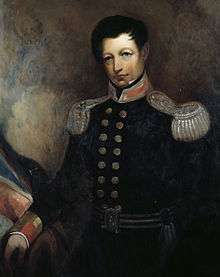
From 1832 James Busby was assigned the post of British Resident in New Zealand. Under his direction the signing of the Declaration of Independence of New Zealand at Waitangi established the post of governor in New Zealand. Captain William Hobson was first appointed Lieutenant-Governor of New Zealand by Letters Patent on 24 November 1840 (having previously been the British Consul to New Zealand), when New Zealand was part of the colony of New South Wales. While Hobson is usually considered the first Governor of New Zealand, Sir George Gipps was the first governor over New Zealand, albeit only in his capacity as Governor of New South Wales, until New Zealand was established as a separate colony on 3 May 1841. Hobson continued in office until his death on 10 September 1842. In Hobson's place the Colonial Office appointed Captain Robert FitzRoy. FitzRoy struggled to keep order between Māori and settlers keen to buy their land, with very limited financial and military resources at his disposal. His conflicts with the New Zealand Company settlements over land deals lead to his recall in 1845.
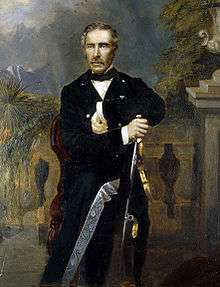
FitzRoy's replacement, Sir George Grey, is considered by some historians, such as Michael King,[80] to be the most important and influential Governor of New Zealand. Grey was the last Governor of New Zealand to act without reference to parliament. During his first term (1845–1852), Grey petitioned the British (Imperial) Parliament to largely suspend the complex New Zealand Constitution Act 1846 (Grey briefly took the title Governor-in-Chief under the Act but this was eventually reverted to Governor), drafting his own constitution bill, which became the New Zealand Constitution Act 1852. Grey's first term ended before responsible government was implemented.
The task of overseeing the transition to responsible government was left to the Administrator of the Government, Robert Wynyard, who opened the 1st New Zealand Parliament on 24 May 1854.[81] Wynyard was quickly confronted by the demands of the new parliament that the parliament be able to appoint its own ministers, instead of the governor. The parliament passed a resolution to that effect on 2 June. Wynyard and the Executive Council of New Zealand refused to allow this, stating that the Colonial Office made no mention of responsible government in its dispatches. Wynyard then offered to add some elected members of parliament to the Executive Council, which he did—a compromise that worked for a few weeks, until on 1 August 1854, Parliament again demanded complete power to appoint ministers. Wynyard refused, and prorogued parliament for two weeks. Then on 31 August he appointed more elected members to the Executive Council, but when parliament met again on 8 August 1855, it moved a motion of no confidence in the members. Fortunately for Wynyard the next Governor, Sir Thomas Gore Browne, arrived on 6 September 1855. Gore Browne's tenure saw the introduction of responsible government, which greatly reduced the powers of the Governor.[81] In the following years, Gore Browne and Premier Edward Stafford clashed over whether the Governor (and hence the imperial government) had control over Māori affairs, a key issue at the time. Stafford began the practice of Cabinet meeting independently of the Executive Council, further reducing the influence of the Governor. Sir George Grey returned to New Zealand in 1861 for a second term. Grey struggled to meet the competing demands of the Colonial and British governments. The New Zealand Wars had brought many British troops to New Zealand, and fearing further fighting Grey, with the support of Edward Stafford, evaded Colonial Office instructions to finalise their return to Britain. In the end the Colonial Office recalled Grey in February 1868.[82]
After Grey, successive governors of New Zealand were derived from the British aristocracy and played a much less active role in government. In only a few instances did the Governor refuse the advice of the Premier—ironically mainly during the tenure of Sir George Grey as Premier of New Zealand from 1877 to 1879.[81] One famous instance of the use of the Governor's powers came during the term of Sir Arthur Gordon. Sir Arthur had left New Zealand on 13 September 1881 for a visit to the Pacific Islands. In his absence, the Premier John Hall advised the Chief Justice James Prendergast, acting as the Administrator of the Government (Prendergast was well known for his views on Māori from his decision in the case Wi Parata v the Bishop of Wellington), to order the invasion of the Māori pacifist Te Whiti o Rongomai's village at Parihaka, something the Governor had indicated he was opposed to.[81]
Governors-General
British citizens
In 1907 Sir Joseph Ward's Liberal government passed a resolution to create New Zealand as the Dominion of New Zealand. This led to new letters patent being issued in 1917, which greatly curtailed the powers of the Governor.[8] To reflect these changes, the office was renamed Governor-General (equivalent to Governors-General of other Commonwealth countries), with the Earl of Liverpool, the serving Governor, being the first Governor-General.
In 1926, following the King-Byng affair in Canada, an Imperial Conference approved the Balfour declaration, which defined a British Commonwealth as a freely associated grouping known as the Commonwealth of Nations. The declaration was ratified by the British Parliament with the Statute of Westminster 1931. The effect of the Declaration was to elevate the Governor-General from a representative of the British government to a regal position with all the theoretical constitutional powers of the Sovereign. New Zealand did not ratify the statute until after the Second World War however, with the Statute of Westminster Adoption Act 1947 being passed on 25 November 1947.
Despite adopting the statute later than most other Commonwealth realms, the functions of the Governor-General in representing the British government were gradually reduced prior to the statute passing. In 1945 Labour Prime Minister Peter Fraser suggested that Sir Bernard Freyberg, the British-born commander of New Zealand's armed forces be appointed Governor-General. Until 1967 the precedent was that Governors-General were nominated by the British Foreign and Commonwealth Office in consultation with the New Zealand Prime Minister, who then recommended appointments to the Sovereign.
New Zealand citizens
In 1967 the first New Zealand-born Governor-General, Sir Arthur Porritt (later Lord Porritt), was appointed to the office, on the advice of Sir Keith Holyoake. Porritt's appointment was followed by Sir Denis Blundell in 1972, who was the first fully New Zealand-resident Governor-General. The appointment of his successor, former Prime Minister Sir Keith Holyoake proved highly controversial, although Holyoake's tenure itself was uncontroversial. In 1983, letters patent were issued once again, further reducing the powers of the office.[8] Following the 1984 constitutional crisis, the 1852 Constitution Act was replaced by the Constitution Act 1986 and the Governor-General's powers further limited. For example, section 16 of the 1986 Act significantly narrowed section 56 of the 1852 Act so that the Governor-General has much less discretion to refuse Royal Assent to Bills of parliament.[38][83]
De facto head of state
| “ | I would go as far as to say that we are already a de facto republic, as is Australia. We have, to all intents and purposes the nominal Head of State in our Governor-General | ” |
| — Prime Minister Helen Clark, March 2002[5] | ||
Increasingly, the Governor-General is regarded as a de facto head of state. Political commentator Colin James has expressed this view,[4] along with historian Gavin McLean[3] and former Prime Minister Helen Clark.[5] The Governor-General has been performing more and more of the functions of a head of state, such as representing New Zealand overseas (a duty Governors-General have carried out since Sir Denis Blundell was in office).[81] For example, at the 2007 commemorations of the Battle of Passchendaele, the Governor-General Anand Satyanand represented New Zealand[84] on behalf of the Queen, while the Queen represented the United Kingdom.[85]
Reform of the office is usually only mentioned in the context of a New Zealand republic. Helen Clark, when defending Dame Silvia Cartwright following a political controversy over prison sentences, stated "[o]ne of the challenges for us is we clearly are no longer a dominion of Britain where the Governor-General is exactly like the Queen. I think we need to consider how the role of governor-general might evolve further. As you know, my view is that one day there will be a president fulfilling the kind of role the governor-general does."[86] Others, such as Professor Noel Cox have argued that the Governor-General's role needs to be updated, rather than reforming the office.[24] Some constitutional academics expressed concern that the process of electoral reform could result in the Governor-General having greater political influence.[31] In 1993, the then Governor-General Dame Catherine Tizard caused controversy by suggesting that under the proposed Mixed Member Proportional (MMP) electoral system, the Governor-General may have to use their reserve powers more often.[87] Following the adoption of MMP at a referendum later in 1993, Prime Minister Jim Bolger suggested at the opening of parliament in 1994 that one reason New Zealand might move to a republic was that the Governor-General would have more influence under the new electoral system.[88]
In December 2009 a review of the Civil List Act 1979 by the Law Commission recommended that part 1 of the Act be repealed, and replaced with a new Governor-General Bill to reflect the nature of the modern office of Governor-General. The most significant change would be that the Governor-General was no longer exempt from paying income tax on their salary. The changes proposed in the report would take effect for the appointment and term of the next Governor-General.[89] The Bill was introduced into Parliament on 28 June 2010[90] and was granted Royal Assent on 22 November 2010.[91]
The Bill passed its first reading unanimously,[26] and the Republican Movement launched 'New Zealand's Next Governor-General' to create a "citizens process" for selecting the next Governor-General.[92]
See also
References
Citations
- ↑ "Governor-General (Salary) Determination 2016". legislation.govt.nz. Parliamentary Counsel Office. 2016. Retrieved 1 June 2017.
- 1 2 Elizabeth II (28 October 1983), Letters Patent Constituting the Office of Governor-General of New Zealand, New Zealand Government Printer
- 1 2 McLean 2006, p. 17.
- 1 2 James, Colin (22 August 2006). "The huge challenge ahead of the Maori Queen's successor". New Zealand Herald. Archived from the original on 6 February 2012.
- 1 2 3 "Republic 'inevitable' – Clark". The Evening Post. 4 March 2002.
- ↑ "Announcement of Honours for Dame Patsy Reddy". Retrieved 14 September 2016.
- 1 2 3 "Roles of the Governor-General". Government House: Governor-General of New Zealand. Retrieved 1 July 2017.
- 1 2 3 Phillip A Joseph (2001). Constitutional and Administrative Law in New Zealand. Wellington: Brookers.
- ↑ Working with David: inside the Lange cabinet by Michael Bassett. Auckland, New Zealand: Hodder Moa. 2008. ISBN 978-1-86971-094-1. Archived from the original on 11 February 2010.
- 1 2 3 Boyce, Peter John (2008). The Queen's Other Realms: The Crown and Its Legacy in Australia, Canada and New Zealand. Federation Press. pp. 175–176. ISBN 9781862877009.
- 1 2 3 Cox 2001, pp. 10–11.
- ↑ Dennis Welch (1 August 2009). Helen Clark: A Political Life. New Zealand: Penguin NZ. ISBN 978-0-14-320241-7.
- ↑ Cox 2001, p. 10.
- 1 2 G.A. Wood (2000). "Holyoake, Keith Jacka". Dictionary of New Zealand Biography.
- ↑ McLean 2006, p. 277.
- ↑ Rowling: The man and the myth by John Henderson, Australia New Zealand Press, 1980.
- ↑ Ross Doughty (1977). The Holyoake years. Feilding.
- ↑ "Patriated". Ministry of Culture and Heritage. Retrieved 12 May 2018.
- ↑ "Sir Geoffrey popular choice for governor-general – poll". New Zealand Herald. 26 November 2004.
- ↑ "Oath of Allegiance". www.beehive.govt.nz. New Zealand Government. Retrieved 30 June 2017.
- ↑ Keith Sinclair (1986), A Destiny Apart – New Zealand's Search for National Identity, Unwin Paperbacks
- ↑ "New Bills". XLIX (4594). The Timaru Herald. 18 July 1889: 3. Retrieved 8 February 2011.
- ↑ Colin James (17 January 2006). "Election: the democratic way to select our Governor-General". The New Zealand Herald. Archived from the original on 22 July 2006.
- 1 2 Noel Cox (8 February 2006). "Governor-General role needs an update". The New Zealand Herald. Archived from the original on 22 October 2009.
- ↑ "Republic newsletter". February 2008. Retrieved 5 May 2008.
- 1 2 Andrea Vance. "New bill doubles governor-general's severance". The Dominion Post.
- 1 2 NZPA (18 August 2010). "Call for 75% support from Parliament for new GGs". Otago Daily Times. Retrieved 18 August 2010.
- ↑ New Zealand Government (31 January 2005). "Governor General's term extended". Scoop.co.nz.
- ↑ "Administrator of the Government". Governor-General of New Zealand. Retrieved 3 September 2017.
- ↑ See, for instance, Willoughby Shortland, "sometime acting Governor of New Zealand".
- 1 2 Stockley, Andrew (1996). "Becoming a republic? Issues of Law". In Luke Trainor. Republicanism in New Zealand. Dunmore Press.
- 1 2 "Republic: Newsletter of the Republican Movement of Aotearoa New Zealand: Putting the case" (PDF). Retrieved 31 March 2007.
- ↑ Simpson, K.A. (1990). "Hobson, William". Dictionary of New Zealand Biography.
- ↑ Wards, Ian (1990). "FitzRoy, Robert". Dictionary of New Zealand Biography. Retrieved 16 February 2018.
- ↑ Sinclair, Keith (1990). "Grey, George". Dictionary of New Zealand Biography. Retrieved 16 February 2018.
- ↑ McLean, Gavin (28 September 2016). "Governors and governors-general". Te Ara: The Encyclopedia of New Zealand. Retrieved 29 June 2017.
- ↑ "Our system of government". New Zealand Parliament. Retrieved 30 June 2017.
- 1 2 3 4 "Constitution Act 1986".
- ↑ Eichbaum, Chris (20 June 2012). "Cabinet government - What is cabinet?". Te Ara: The Encyclopedia of New Zealand. Retrieved 1 July 2017.
- ↑ McLean, Gavin (13 December 2016). "Premiers and prime ministers". Te Ara: The Encyclopedia of New Zealand. Retrieved 30 June 2017.
- ↑ Macauley, G.A. (1994). "Honours and Arms: Legal and Constitutional Aspects of Practice Concerning Heraldry and Royal Honours in New Zealand". Canterbury Law Review. 5 (3).
- ↑ "Seal of New Zealand Act 1977".
- ↑ "Executive Council – Cabinet Manual". Department of the Prime Minister and Cabinet. Retrieved 1 September 2016.
- ↑ Brasher, Norman Henry (1971). Studies in British Government. Springer. p. 13. ISBN 9781349154500. Retrieved 14 May 2018.
- 1 2 McLean, Gavin. "Governors and governors-general - Constitutional duties". Te Ara: The Encyclopedia of New Zealand. Retrieved 15 May 2018.
- 1 2 Sir Geoffrey Palmer and Matthew Palmer (2004). Bridled Power: New Zealand's Constitution and Government (Fourth ed.). Oxford University Press. ISBN 0-19-558463-5.
- 1 2 "Modern duties". Ministry for Culture and Heritage. 14 June 2014. Retrieved 1 July 2017.
- 1 2 Dame Silvia Cartwright (23 June 2006). "Modern aspects of the role of the Governor‑General of New Zealand". Governor-General of New Zealand. Retrieved 13 August 2007.
- ↑ Sir Kenneth Keith (2008). "On the Constitution of New Zealand: An Introduction to the Foundations of the Current Form of Government". Retrieved 12 September 2011.
- ↑ "The Reserve Powers". Governor-General of New Zealand. Retrieved 1 July 2017.
- ↑ Philip Joseph (2002). Constitutional and Administrative Law in New Zealand (Second ed.). Brookers. ISBN 978-0-86472-399-4.
- ↑ "The Executive and the Whitlam Dismissal". Northern Territory University. Retrieved 22 May 2009.
- ↑ Fitzgerald v Muldoon 2 NZLR 615 (1976)
- ↑ "The Royal Prerogative of Mercy". Governor-General of New Zealand. Retrieved 1 July 2017.
- ↑ "A timeline of David Bain's case". Radio New Zealand. 2 August 2016. Retrieved 1 July 2017.
- ↑ Yang, Unity Elias (2014). Last Great Queen?: Elizabeth II, Mother of leadership, Seen from the crowd. AuthorHouse. p. 189. ISBN 9781491895160.
- ↑ McLean 2006, pp. 16–17.
- ↑ "Review of Defence Force Standards of Behaviour". State Services Commission. 16 July 2002. Retrieved 13 July 2007.
- ↑ "The Governor-General's role as Commander-in-Chief". The Governor-General of New Zealand. 10 December 2008. Retrieved 24 October 2016.
- ↑ "Vice-Regal Patronage". Governor-General of New Zealand. Retrieved 29 June 2017.
- ↑ McLean, Gavin (28 September 2016). "Governors and governors-general - Community duties". Te Ara: The Encyclopedia of New Zealand. Retrieved 29 June 2017.
- ↑ "Governor-General issues New Year message for 2009". Government House: Governor-General of New Zealand. 2 January 2009. Retrieved 2 January 2009.
- ↑ "The Governor-General's Rolls-Royce". New Zealand Ministry for Culture and Heritage. Retrieved 21 September 2010.
- ↑ "Cost of the Monarchy". Monarchy New Zealand. 2009. Archived from the original on 5 February 2013. Retrieved 2 October 2010.
- ↑ "Vote Prime Minister and Cabinet" (PDF). New Zealand Treasury. May 2010. pp. 269–270. Retrieved 2 October 2010.
- ↑ "Monarchy New Zealand Calls for the Resignation of Republican Chair" (PDF). 28 October 2010. Archived from the original (PDF) on 22 July 2011. Retrieved 15 November 2010.
- ↑ "Governor-General (Salary) Determination 2016". legislation.govt.nz. Parliamentary Counsel Office. 2016. Retrieved 1 June 2017.
- ↑ "Civil List Act 1979". Knowledge Basket. Retrieved 8 August 2007.
- ↑ "Governor-General Act 2010 No 122 (as at 01 March 2017), Public Act". New Zealand Legislation. Retrieved 30 June 2017.
- ↑ "Government House". Governor-General of New Zealand. Retrieved 30 June 2017.
- ↑ Michelle Duff (28 March 2011). "Government Houses $44m facelift". Retrieved 18 April 2011.
- ↑ "Speech at the opening of the Government House Visitor Centre, Wellington". Government House, Wellington: Governor-General of New Zealand. 14 November 2012. Retrieved 30 June 2017.
- ↑ "2015 Order of Precedence in New Zealand" (PDF). Governor-General of New Zealand. Archived from the original (PDF) on 4 March 2016. Retrieved 30 June 2017.
- ↑ Rt. Hon. Helen Clark (17 July 2006). "Changes to rules around use of title". The Department of the Prime Minister and Cabinet of New Zealand. Archived from the original on 27 September 2007. Retrieved 21 August 2007.
- ↑ Statutes of the New Zealand Order of Merit 1996, reg 5
- ↑ Statutes of the Queen's Service Order 1975, reg 4
- ↑ "The Governor-General's flag". Governor-General of New Zealand. Retrieved 30 June 2017.
- ↑ Dress worn at His Majesty's court : issued with the authority of the Lord Chamberlain (1912), pp. 49, 50
- 1 2 3 Cox 2001, p. 20.
- ↑ Michael King (2003). The Penguin History of New Zealand. Penguin.
- 1 2 3 4 5 McLean 2006.
- ↑ Keith Sinclair (7 April 2006). "Dictionary of New Zealand Biography George Grey 1812 – 1898". Retrieved 3 July 2007.
- ↑ Sir Geoffrey and Matthew Palmer (2001). Bridled Power – New Zealand's Constitution and Government. Oxford University Press.
- ↑ "Governor-General visits Belgium for Passchendaele Commemoration". Government House. 6 July 2007.
- ↑ Associated Press (11 July 2007). "Queen Elizabeth II, Belgian royals pay tribute to allied soldiers of Passchendaele battle". International Herald Tribune. Archived from the original on 20 February 2008.
- ↑ NZPA (15 August 2002). "Clark foresees president role". New Zealand Herald. Retrieved 23 July 2007.
- ↑ Cox, Noel (2002). "The Effect of the Advent of the Mixed-Member Proportional Voting System Upon the Role of the Governor-General of New Zealand". University of Auckland. p. 434. Retrieved 27 October 2016.
- ↑ Jim Bolger (March 1994). Address-In-Reply debate, state opening of Parliament.
- ↑ "Review of the Civil List Act 1979: Law Comm Report". New Zealand Law Commission. 17 December 2009. Retrieved 18 December 2009.
- ↑ "Parliament of New Zealand – Order Paper" (PDF). Parliament of New Zealand. 30 June 2010.
- ↑ "Governor-General Act 2010".
- ↑ "Media release – Governor-General Bill good start at reform". Scoop.co.nz. 20 July 2010. Retrieved 21 July 2010.
Bibliography
- Cox, Noel (2001). "The Evolution of the Office of Governor-General of New Zealand" (PDF). Mountbatten Journal of Legal Studies. 5 (1–2). doi:10.2139/ssrn.420740. Retrieved 30 June 2017.
- McLean, Gavin (2006), The Governors: New Zealand's Governors and Governors-General, Dunedin: Otago University Press, ISBN 1-877372-25-0
Further reading
- Quentin-Baxter, Alison; McLean, Janet (2017). This Realm of New Zealand: The Sovereign, the Governor-General, the Crown. Auckland University Press. ISBN 978-1-869-40875-6.
External links
| Wikimedia Commons has media related to Governors-General of New Zealand. |
- Official website of the Governor-General
- History of the Governor-General, NZHistory
- Former Governors-General, the Governor-General website
